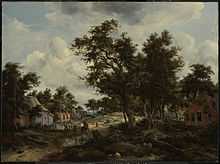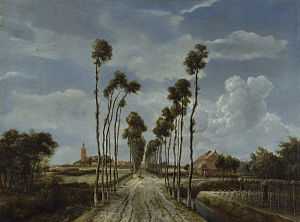Meindert Hobbema



Meindert Hobbema (bapt. October 31, 1638 – December 7, 1709), was a Dutch Golden Age landscape painter.
Life
Born to Lubbert Meynerts and Rinsje Eduwarts, Hobbema was baptized as Meyndert Lubbertsz in Amsterdam on October 31, 1638. At the age of 15, he and his younger brother and sister are recorded as having been sent to an orphanage.[1] Although he signed his name M. Hobbema on paintings as early as 1658, he used only his baptized name on legal documents until 1660.[2]
Marriage and Career
Meindert Hobbema married Eeltien (Eeltje) Vinck in the Oude Kerk (Old Church) at Amsterdam, on 2 November 1668.[3] Vinck was a kitchen maid to Lambert Reynst, a burgomaster of Amsterdam. Witnesses to the marriage were the bride's brother Cornelius Vinck and the landscape painter Jacob van Ruisdael. It is documented that Ruisdael was Hobbema's teacher, as in July 1660 Ruisdael testified Hobbema "served and learned with me for several years."[4]
In the same year Hobbema married, he took up the well-paid post of municipal wine gauger for the Amsterdam octroi (civic tax collectors), a job that involved the weighing and measuring of imported wines. With a wife, a job and a salary, his painting output slowed down considerably.[5] Hobbema and his wife had five children and lived in the Rozengracht, not far from Rembrandt, who moved there in his later and impoverished days. In 1704 Eeltien died and was buried in the pauper section of the Leiden cemetery at Amsterdam. Hobbema survived until late 1709 and was buried a pauper on 14 December in the Westerkerk cemetery at Amsterdam.
Work
| Wikisource has original text related to this article: |
Meindert Hobbema specialized in painting wooded landscapes inspired by the flat countryside of the eastern region of the Dutch Republic. Almost without exception Hobbema's subject matter was drawn from the heavily wooded landscape of the eastern Netherlands. The majority of his paintings fall into the following categories:
- dirt roads by farms in woods;
- water mills near or set back into woods;
- pools at the edge of woods, usually with farms or villages in the distance;
- ruins in woods.[6]
The impact of Ruisdael’s work on Hobbema is not apparent until after 1660. Hobbema’s earlier work seems more closely related to the lighter and more delicate landscapes of Jacob’s uncle Salomon van Ruysdael (Dutch, 1600/1603 - 1670). Although he painted infrequently after marriage, Hobbema produced his most celebrated work, The Avenue at Middelharnis [7] (1689, National Gallery, London) during this period.
Today Hobbema is viewed as one of the most characteristic and highly valued Dutch landscape painters of the seventeenth century, but he is not mentioned in a single seventeenth-century literary source. The earliest reference to his work occurs in Johan van Gool’s 1751 lexicon of Dutch artists, where Hobbema is mentioned in passing as having painted “modern landscapes.”
Although Georges Broulhiet[8] attributes about five hundred paintings to Hobbema in his monograph, many of his attributions cannot be defended. A number of the paintings he gives to Hobbema are by contemporaries who painted in similar styles, as for example Jan van Kessel (Flemish, 1626 - 1679). Others are probably nineteenth-century imitations painted at a time when Hobbema’s style was extremely fashionable. Nevertheless, a range of quality does exist in paintings whose attribution to Hobbema seems justifiable. Although we have no documentary evidence about his workshop practices, it seems likely that he had assistants working under his direct supervision, producing variations of his compositions. He also may have employed a number of staffage specialists to paint small figures in his landscapes. [4]
Other
- In 1891 a hamlet in Alberta (Canada) was called Hobbema after the painter. On 1 January 2014 the name was changed to Maskwacis (meaning Bear Hills) on request of the native Cree who live in the area.[9][10]
Notes
- ↑ National Gallery, London. "Meindert Hobbema". Retrieved 30 June 2014.
- ↑ Wheelock, Arthur. "Meindert Hobbema".
- ↑ Liedke, Walter (2007). Dutch Paintings in the Metropolitan Museum of Art. New York: Metropolitan Museum of Art. p. I: 341.
- ↑ 4.0 4.1 Wheelock, Arthur. "Meindert Hobbema".
- ↑ National Gallery London. "Meindert Hobbema".
- ↑ Keyes, G.S. "Meindert Hobbema". Allen Memorial Art Museum, Oberlin College.
- ↑ "Meindert Hobbema - The Avenue at Middelharnis - NG830 - The National Gallery, London". nationalgallery.org.uk. Retrieved 18 January 2015.
- ↑ "Meindert Hobbema (1638-1709); ouvrage illustre虂 de 590 grandes reproductions photographiques dont 450 tableaux du mai虃tre et plus de cent de虂tails,". worldcat.org. Retrieved 18 January 2015.
- ↑ "CivicWeb: Sept 3, 2013 Regular Meeting". civicweb.net. Retrieved 18 January 2015.
- ↑ Article in the online version of the Calgary Herald of 31 December 2013.
References
- Cundall, Frank. The landscape and pastoral painters of Holland (Scribner & Welford, 1891) pp. 39–62.
 This article incorporates text from a publication now in the public domain: Chisholm, Hugh, ed. (1911). "Hobbema, Meyndert". Encyclopædia Britannica (11th ed.). Cambridge University Press.
This article incorporates text from a publication now in the public domain: Chisholm, Hugh, ed. (1911). "Hobbema, Meyndert". Encyclopædia Britannica (11th ed.). Cambridge University Press.
External links
| Wikimedia Commons has media related to Meindert Hobbema. |
| Wikisource has the text of the 1911 Encyclopædia Britannica article Hobbema, Meyndert. |
- Hobbema online (ArtCyclopedia)
- Web Gallery of Art
- Works and literature at PubHist
- Hobbema biography ("History of Holland")
- A monumental Hobbema
- A Pond in the Forest, 1868 (Allen Memorial Art Museum)
- The Avenue at Middelharnis (1689 painting)
|